UK: Aspen Hawkmoth, F: Sphinx du Tremble, D: Zitterpappelschwärmer; Espenschwärmer, RUS: Osinovyi Brazhnik, S: Asp-Nattsvärmare, PL: Zawisak osinowiec; Nastrosz osinowiec, FIN: Haapakiitäjä, EST: Hall-haavasuru.
Smerinthus tremulae var. amurensis Staudinger, 1892, in Romanoff (ed.), Mém. Lépid. 6: 232.Type locality: [Russia, Khabarovsk Krai/Primorskiy Krai,] Ussuri.
(Taxonomic notes. (i) This species is often referred to as Laothoe tremulae. However, as Sphinx tremulae Boisduval is a junior primary homonym of Sphinx tremulae Borkhausen, 1793 (see Laothoe populi populi (Linnaeus, 1758)), the next oldest available name must be used.
(ii) Subsp. baltica Viidalepp, 1979, is not tenable as it is clearly only a form that appears occasionally within the European range of the nominate subspecies. However, Zolotuhin (pers. comm.) disputes this and states that all western Palaearctic material should be referred to as subsp. baltica.
(iii) Laothoe amurensis sinica (Rothschild & Jordan, 1903) is found in central-eastern China, from Jilin Province in the north to Gansu and southern Shaanxi. Notable localities are the Daba (Tapa) Shan and Qinling (Tsinling) mountain ranges south of Xi'an. Chu & Wang (1980b) also record Laothoe amurensis sinica from western China, but this is probably erroneous.
(iv) The closely related but somewhat isolated Laothoe amurensis selene Zolotuhin, 2018 is found along the eastern foothills of the Tibetan plateau and in northern Yunnan Province, China.
(v) A new subspecies, namely Laothoe amurensis zolotuhini, has been proposed by Spitsyn, Bolotov & Spitsyna (2022) for the Japanese and Kurile Island (Kunashir Island) populations. Morphologically, it was said to differ from the nominotypical subspecies only in having a strongly toothed outer margin to the wings. However, examination of the long series of Japanese specimens in NHMUK suggests that this feature does not hold. That leaves only a DNA barcode divergence of 2.12-2.45% from the compared Eurasian mainland population as there are no differences in the male genitalia (and none was proposed in the original description). However, as no Japanese specimens were included in the analysis of Spitsyn et al. (2022) it is unclear what the relationship is between the population (ssp. zolotuhini) on Kunashir and the Japanese populations on Hokkaido and Honshu (and also those on Sakhalin Island, Russian Far East)) (Ian Kitching, pers. comm. 2022).
[Further details on this species, as well as photos of all stages, can be found on Lepiforum.]
Holarctic; Palaearctic (both eastern and western). Pleistocene refuge: Monocentric -- Manchurian refuge.

Wingspan: 75--95mm. Closely resembles Laothoe populi populi, but immediately distinguishable by the absence of the rust-red patch at base of hindwing, although there may be a tint of brown present in some individuals. Ground colour equally variable, ranging from buff through pink to various shades of grey. The small, dark-grey form is referable to f. baltica Viidalepp. According to Rothschild & Jordan (1903), in the male genitalia, the sacculus is much broader than in Laothoe populi populi, the two lobes (processes) being very broad; the phallus is multispinose around almost all the edge, with the spines being small on one side; uncus shorter than in Laothoe populi populi, gnathos more evenly convex below, its sides straighter, the apex more obtuse.



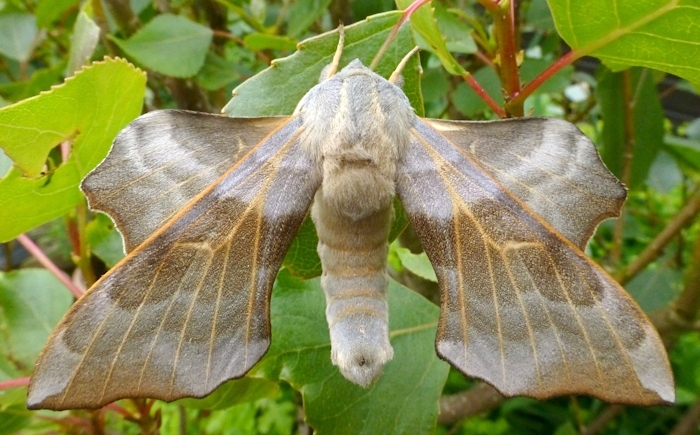
This species is found in woodland clearings and on lake margins abounding in Populus tremula (aspen); rarely elsewhere.
The behaviour of Laothoe amurensis amurensis is very similar to that of Laothoe populi populi. It rarely flies before midnight and has often been seen to fly to and fro over still water, dipping into it repeatedly (Skvortsov & Thomson, 1974). Certain tropical sphingids, such as species of Pachylia Walker, Hemeroplanes Hübner and Perigonia Herrich-Schäffer, are known to drink and this species may do the same. Individuals in any one population tend to emerge within 5--7 days of one another and have a very short lifespan of only 6--10 days. This suggests that this species is a true denizen of boreal climatic conditions, i.e. short, warm summers and long cold winters.
Univoltine. Both sexes are strongly attracted to light between late May and early July, depending on locality, with the main flight period around the first 10 days of June (Skvortzov & Thomson, 1974). In the southern Urals, from mid June until early July (Nupponen & Fibiger, 2002).
However, if reared under warm conditions in captivity this species will produce a partial to full second brood, indicating that this may also happen under natural conditions (Roger Perkins, pers. comm. 2002).
OVUM: Glossy, greenish yellow, rather large for size of moth (2.3 x 2.0 x 1.9mm) and dorso-ventrally flattened. Each female deposits fewer than 100 eggs, singly, on the underside or petiole of a leaf, hatching 10--12 days later.


LARVA: Full-fed 65--80mm. Dimorphic: bluish-green with a blue horn, and yellowish-green with a horn of the same colour.



The newly-emerged larva is pale green with faint yellow markings appearing after feeding. In the second instar, it assumes its final coloration and form, which is bluish green (sometimes dark green) with white oblique lateral stripes on abdominal segments 1--8 and covered in white tubercles. Resembles that of Laothoe populi populi, except that the spiracles are larger and a pair of enlarged tubercles are present dorsally on thoracic segment 2; these tubercles become more noticeable as the larva grows (Pelzer, 1989). The spiracles are white, ringed with brown, and the short horn is yellowish-green or bluish, dotted laterally with white. As in Laothoe populi populi, it assumes a light plum colour prior to pupation.
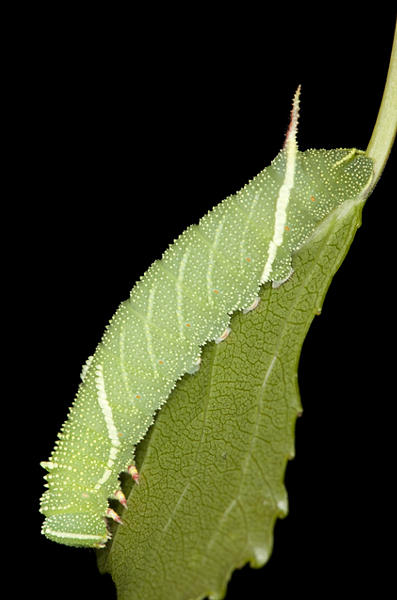

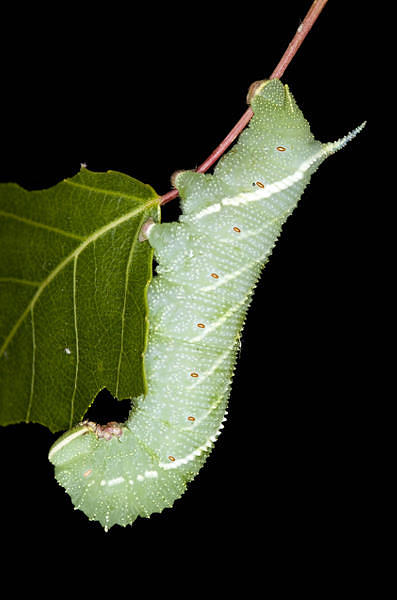

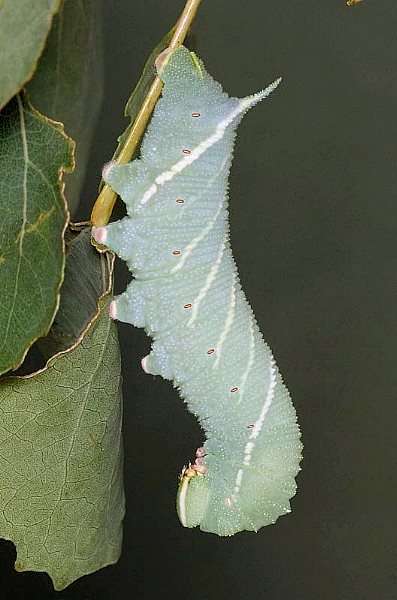



On hatching, the larva commences feeding immediately on mature leaves. At first, these are skeletonized but, with increasing size, whole leaves are consumed except for the midrib (Skvortsov & Thomson, 1974). However, like the larva of Laothoe populi populi, it is a wasteful feeder, with large segments of leaf being chewed off and falling to the ground. It feeds at night and, at first, rests by day stretched out under a leaf. In the second and later instars it assumes a sphinx-like attitude with its head hunched under the thorax; only the last 2--3 pairs of prolegs cling to the leaf. Fully-grown larvae tend to rest singly along a petiole, high up in mature trees where their colour enables them to blend superbly with the surrounding blue-green aspen leaves. When feeding on Populus, most individuals complete only four instars before pupation; some, however, pass through five instars, as do those feeding on Salix. This stage takes about 40--50 days, the resulting mature larva being larger than that of Laothoe populi populi.
Occurs from late June to early August. In Siberia, larvae can sometimes be so abundant as to constitute a pest (Gninenko, 1998).
Major Hostplants. Populus tremula and P. lancifolia (Elämet, 1954)
Minor Hostplants. Salix and other Populus spp.
PUPA: 30--43mm. In colour and shape, almost identical to that of Laothoe populi populi, except for the presence of a two-tier cremaster. Pupation normally takes place after only about four days in an unlined chamber, 2--3cm deep in the soil at the base of a tree or in a grass tussock. The overwintering stage.


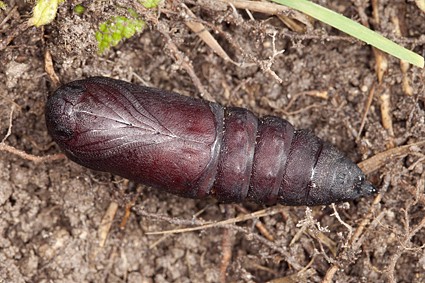

Ichneumonidae: Netelia testacea (Gravenhorst, 1829), Netelia vinulae (Scopoli, 1763).
From southern Finland (Elämet, 1954; Nordstroem & Wahlgren, 1961), eastern Poland (Derzhavets, 1984), Belarus (Merzheevskaya et al., 1976), Estonia (Petersen, 1924; Thomson, 1967; Skvortsov & Thomson, 1974; Kesküla, 1992), Latvia and Lithuania (Kazlauskas, 1984), across european Russia (recorded as far north as Irael' (Tatarinov, Sedykh & Dolgin, 2003), northern Kazakhstan (Danner, Eitschberger & Surholt, 1998), western Siberia (Knyazev, 2020) to the Altai Mountains of both Russia (Zolotarenko, Petrova & Shiryaev, 1978; Viidalepp, 1979) and China (Zhang, D. Y. et al., 1986). Although quite widely distributed in northern Europe, its occurrence may go undetected for long periods due to low population densities and a preference for remote, inaccessible regions. However, new localities are regularly being discovered as moth-traps are increasingly deployed in wilder regions.
Reported as being 'common' in Daghestan, southern Russia (Abdurahmanov, 1999), but this may be a mistake as this region of the Caucasus is well outside the normal range of this species.
Extra-limital range. Southern and eastern Siberia, Tuva ASSR, southern Yakutia/Sakha (Kaimuk et al., 2005), Buryatia, Amurland, Ussuri, Sakhalin Island (Zolotarenko, Petrova & Shiryaev, 1978; Dubatolov, 1991), the Kurile Islands (Dubatolov, 1991), northern Mongolia, north-eastern China (Heilongjiang; northern Nei Mongol) and Japan (Hokkaido; Honshu). Records from areas of China southwest of Jilin Province are erroneous and refer to the closely related Laothoe amurensis sinica. Records from Korea (Kim, Nam & Lee, 1982) need confirmation as some may also be of Laothoe amurensis sinica; all specimens examined so far have been Laothoe amurensis sinica.
Central-northern China, from Jilin Province in the north to Gansu and southern Shaanxi, as Laothoe amurensis sinica (Rothschild & Jordan, 1903). Sichuan, the eastern foothills of the Tibetan plateau, and northern Yunnan Province as Laothoe amurensis selene Zolotuhin, 2018.

 Return to species list
Return to species list